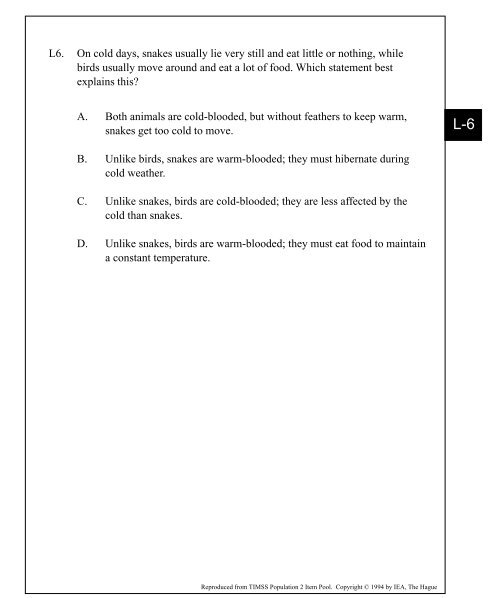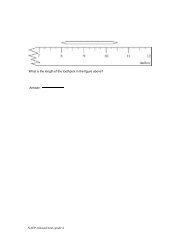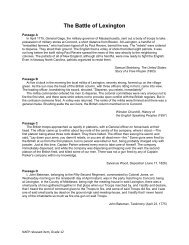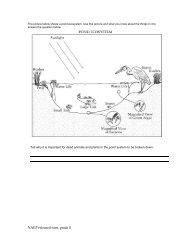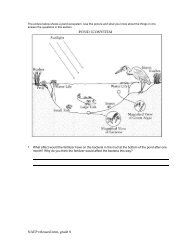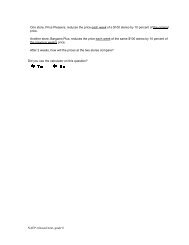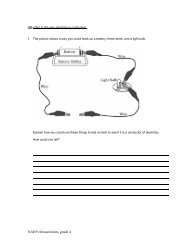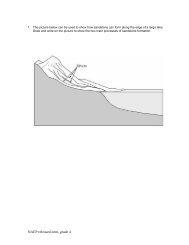Snakes and birds on a cold day. (T2) - McREL
Snakes and birds on a cold day. (T2) - McREL
Snakes and birds on a cold day. (T2) - McREL
Create successful ePaper yourself
Turn your PDF publications into a flip-book with our unique Google optimized e-Paper software.
L6. On <strong>cold</strong> <strong>day</strong>s, snakes usually lie very still <str<strong>on</strong>g>and</str<strong>on</strong>g> eat little or nothing, while<br />
<str<strong>on</strong>g>birds</str<strong>on</strong>g> usually move around <str<strong>on</strong>g>and</str<strong>on</strong>g> eat a lot of food. Which statement best<br />
explains this?<br />
A. Both animals are <strong>cold</strong>-blooded, but without feathers to keep warm,<br />
snakes get too <strong>cold</strong> to move.<br />
L-6<br />
B. Unlike <str<strong>on</strong>g>birds</str<strong>on</strong>g>, snakes are warm-blooded; they must hibernate during<br />
<strong>cold</strong> weather.<br />
C. Unlike snakes, <str<strong>on</strong>g>birds</str<strong>on</strong>g> are <strong>cold</strong>-blooded; they are less affected by the<br />
<strong>cold</strong> than snakes.<br />
D. Unlike snakes, <str<strong>on</strong>g>birds</str<strong>on</strong>g> are warm-blooded; they must eat food to maintain<br />
a c<strong>on</strong>stant temperature.<br />
Reproduced from TIMSS Populati<strong>on</strong> 2 Item Pool. Copyright © 1994 by IEA, The Hague
L6. On <strong>cold</strong> <strong>day</strong>s, snakes usually lie very still <str<strong>on</strong>g>and</str<strong>on</strong>g> eat little or nothing, while<br />
<str<strong>on</strong>g>birds</str<strong>on</strong>g> usually move around <str<strong>on</strong>g>and</str<strong>on</strong>g> eat a lot of food. Which statement best<br />
explains this?<br />
A. Both animals are <strong>cold</strong>-blooded, but without feathers to keep warm,<br />
snakes get too <strong>cold</strong> to move.<br />
L-6<br />
B. Unlike <str<strong>on</strong>g>birds</str<strong>on</strong>g>, snakes are warm-blooded; they must hibernate during<br />
<strong>cold</strong> weather.<br />
C. Unlike snakes, <str<strong>on</strong>g>birds</str<strong>on</strong>g> are <strong>cold</strong>-blooded; they are less affected by the<br />
<strong>cold</strong> than snakes.<br />
D. Unlike snakes, <str<strong>on</strong>g>birds</str<strong>on</strong>g> are warm-blooded; they must eat food to maintain<br />
a c<strong>on</strong>stant temperature.<br />
Reproduced from TIMSS Populati<strong>on</strong> 2 Item Pool. Copyright © 1994 by IEA, The Hague<br />
Internati<strong>on</strong>al Average<br />
Subject Item Key C<strong>on</strong>tent Category Performance<br />
Percent of Students<br />
Resp<strong>on</strong>ding Correctly<br />
Internati<strong>on</strong>al<br />
Difficulty<br />
Expectati<strong>on</strong> Upper Grade Lower Grade Index<br />
Science D Life Science 54% 50% 571<br />
Theorizing, Analyzing,<br />
<str<strong>on</strong>g>and</str<strong>on</strong>g> Solving Problems<br />
41


